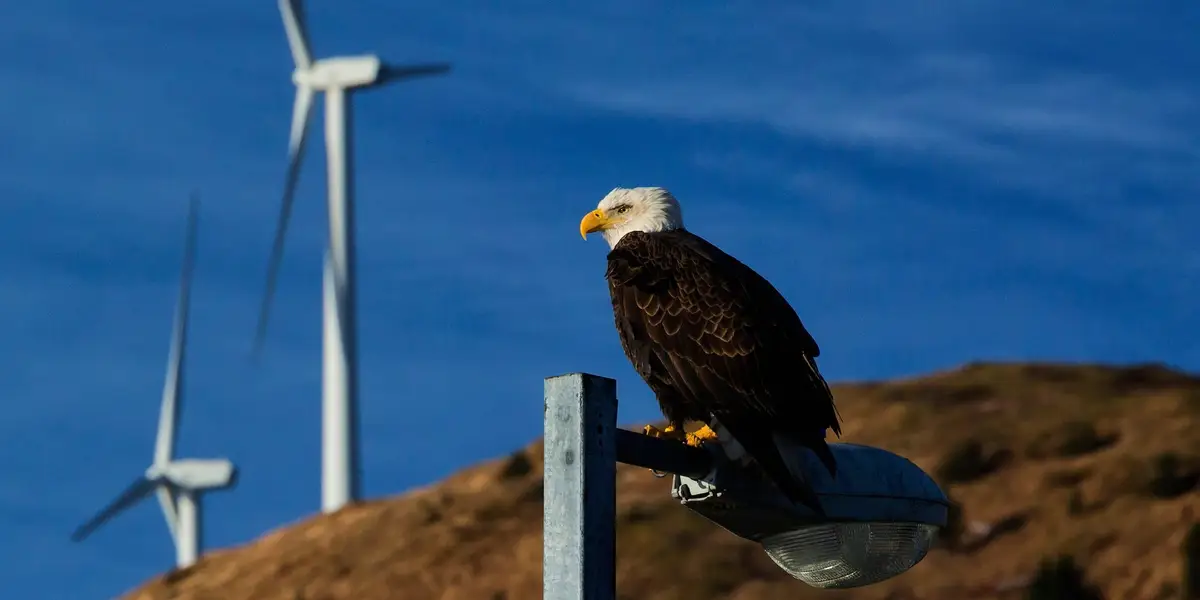Wind turbines have been championed as a leading solution to the climate crisis, providing renewable energy with no emissions. However, this narrative often overlooks the significant negative impacts that wind turbines have on the environment and wildlife, especially birds of prey. The damage caused by windmills extends beyond bird fatalities, encompassing issues like habitat disruption, ecological imbalance, and even potential health concerns for humans. This article delves into why wind turbines may not be the green solution they are often portrayed to be.
Wind Turbines and Bird of Prey Fatalities
Wind turbines have a deadly impact on bird populations, particularly on birds of prey such as eagles, hawks, and owls. These raptors are not only essential to their ecosystems but are also often protected by law due to their vulnerable status. Studies indicate that the spinning blades of wind turbines cause hundreds of thousands of bird deaths annually. The American Bird Conservancy estimates that wind turbines kill up to 500,000 birds each year in the U.S., with raptors being disproportionately affected.
Birds of prey are especially vulnerable to wind turbines for several reasons:
- Flight Patterns: Raptors often fly at altitudes that intersect with the rotor blades of wind turbines. Unlike smaller birds that may fly under the turbines, raptors often soar higher, putting them directly in the path of the rotating blades.
- Hunting Behavior: Birds of prey, such as eagles and hawks, have acute vision and focus intently on their prey while hunting. This behavior makes them less likely to notice and avoid wind turbines, increasing their risk of collision.
- Long Lifespans and Low Reproductive Rates: Birds of prey typically have longer lifespans and lower reproductive rates than other birds. This means that the death of even a small number of individuals can have a significant impact on the overall population, potentially leading to long-term declines.
Ecological Consequences
The decline of birds of prey has far-reaching consequences for ecosystems. Raptors play a critical role in controlling the populations of rodents and other small animals, helping to maintain a balanced ecosystem. For example, hawks and owls keep rodent populations in check, preventing overgrazing and the spread of disease. The loss of these apex predators can lead to an increase in prey populations, which can, in turn, cause cascading ecological effects. When birds of prey decline, ecosystems can become imbalanced, leading to unforeseen environmental issues.
Habitat Disruption and Fragmentation
Wind farms not only kill birds directly but also cause habitat disruption and fragmentation. The large tracts of land required for wind farms often result in the destruction of natural habitats, which can have a detrimental impact on local wildlife. In some cases, the construction and operation of wind farms have been linked to the displacement of bird populations, forcing them into less suitable habitats where they may struggle to survive.
The Altamont Pass Wind Resource Area (APWRA) in California is a prime example of the ecological impact of wind farms. The area, which hosts thousands of wind turbines, is also a critical habitat for a variety of bird species, including the golden eagle. Research conducted at Altamont Pass has revealed that the wind turbines there kill 75 to 100 golden eagles each year. The displacement and death of these birds not only threaten the local eagle population but also disrupt the broader ecosystem, demonstrating the unintended consequences of wind energy development.
The Myth of Carbon Neutrality
Proponents of wind energy often argue that the benefits of reducing carbon emissions outweigh the negative environmental impacts. However, this argument is not as clear-cut as it seems. While wind energy does produce zero emissions during operation, the full lifecycle of a wind turbine—from manufacturing and installation to maintenance and decommissioning—does have a carbon footprint.
The production of wind turbines involves the extraction and processing of raw materials, including steel, concrete, and rare earth metals. This process is energy-intensive and contributes to greenhouse gas emissions. Additionally, wind turbines have a limited lifespan of around 20 to 25 years. Decommissioning old turbines and replacing them with new ones requires further energy and resources, creating an ongoing cycle of environmental impact.
Furthermore, wind energy’s intermittent nature means that it cannot provide a constant power supply. To ensure a stable energy grid, wind power must often be supplemented by other energy sources, including fossil fuels. This reliance on backup power plants can reduce the overall emissions savings of wind energy, calling into question its effectiveness as a truly carbon-neutral solution.
The Human Impact: Health Concerns
In addition to the environmental impacts, wind turbines have been associated with potential health concerns for humans living near wind farms. Some residents living close to wind turbines report experiencing symptoms such as headaches, sleep disturbances, and dizziness, a phenomenon often referred to as “wind turbine syndrome.” While the scientific community is still debating the causes and extent of these symptoms, they cannot be dismissed outright.
Noise pollution from wind turbines, particularly low-frequency noise and infrasound, is a potential factor contributing to these health issues. Unlike regular noise, low-frequency noise can travel long distances and penetrate buildings, making it difficult for nearby residents to escape its effects. Even if these health concerns affect only a small portion of the population, they raise questions about the social acceptability of large-scale wind energy development.
Exploring Alternatives: A Balanced Energy Mix
While wind energy has its place in the pursuit of renewable energy, it should not be viewed as a one-size-fits-all solution. The environmental and health issues associated with wind turbines underscore the need for a diversified approach to renewable energy. Solar power, hydroelectricity, and emerging technologies like geothermal energy and tidal power offer alternative sources of clean energy that may have less impact on wildlife and human health.
Additionally, advancements in energy storage technology could help mitigate some of the issues associated with renewable energy’s intermittent nature. By improving our ability to store and distribute energy efficiently, we can reduce our reliance on backup power plants and create a more stable and sustainable energy grid.
Rethinking the Role of Wind Energy
Wind turbines have been promoted as a key solution to the climate crisis, but the reality is more complex. The issue of windmills killing birds of prey, along with habitat disruption, carbon emissions from manufacturing, and potential human health concerns, reveals that wind energy is not without its environmental costs. While renewable energy is crucial for a sustainable future, we must critically evaluate the trade-offs associated with each energy source and strive for a balanced energy mix that minimizes harm to both wildlife and human communities.
In our quest for a greener future, it is essential to take a holistic approach to energy development, one that considers the full spectrum of environmental, social, and economic impacts. Wind turbines may have a role to play, but they should not be implemented without careful consideration of their effects on the environment and human well-being. By seeking a more balanced and responsible approach to renewable energy, we can work toward a future that is truly sustainable for all forms of life on our planet.
Image at top is Copyright Marion Owen/Getty images.

